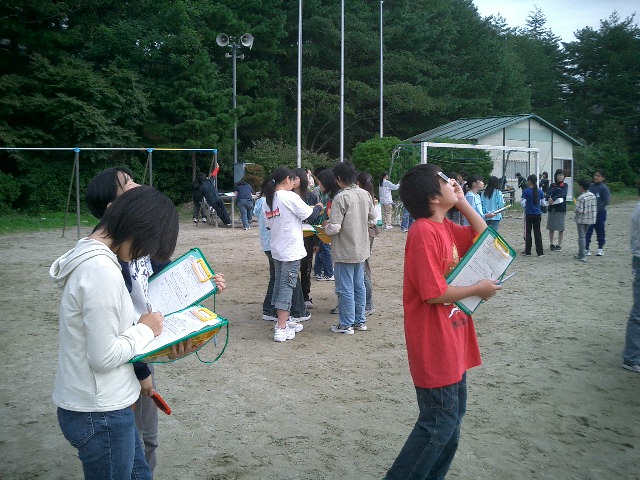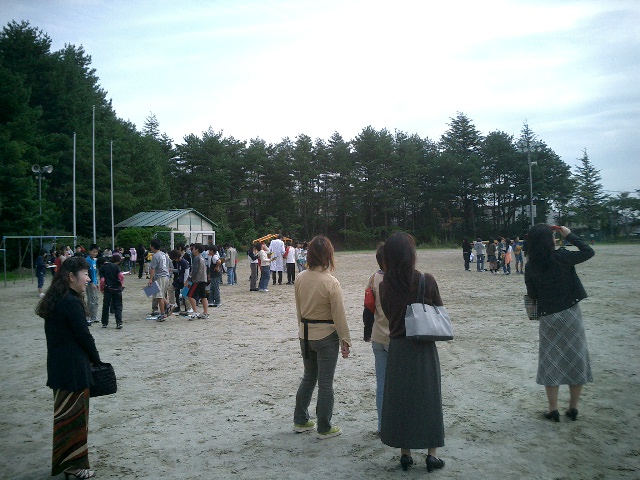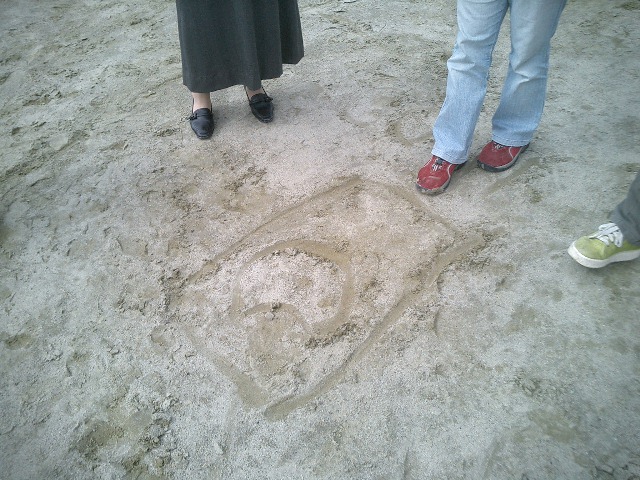HOME|Ideas and resoueces for planetary science experiments|Yagiyama Primary School (2004)
宇宙の実験教室
Ideas and resoueces for planetary science experiments
カテゴリ
Category
- 実験教室Idea and Resources for Space science experiments
- 対象項目別Category: Contents
- 学年単元別Category: Study Age
-
- 実践授業Activity Reports
タグ
Tag
 日食を観察しよう(仙台市立八木山小学校6年 2004)
日食を観察しよう(仙台市立八木山小学校6年 2004)
事前指導の内容
1週間前 日食についての予備知識を得る
日食の1週間前、2004年10月7日に、日食に関する予備知識をもってもらうために、授業をしました。
順序
1.「日食」について見たり聞いたりして知っていることを書き、発表する。
2.発表の内容をもとにして、さらに詳しい説明を聞く。 説明内容は以下のポイントについて。
- どういうときに日食が起こるか。
- 地球の上に月の影が映る様子
- 地球からの太陽と月の視直径
- 日食の種類
3.観察の仕方に関する諸注意を聞く。
授業を実施して
日食という言葉を聞いたことのある児童は半数ほどでした。さらに、「太陽が 月にかくされる現象」という説明のできる子は3名ほどでした。
日食の説明は、プレゼンテーションソフトを用い、地球上に月の影が映る様子をみたり、皆既日食、金環日食、部分日食について説明しました。
3種類の日食については、児童1人に協力してもらい、児童の顔を太陽、木琴のバチを月、カメラを地球に見立てて説明しました。この場面では児童はとても面白がり、実際の天体の位置関係と地球上からの見え方の関係の理解もしやすかったようです。
2004年10月14日部分日食の観察
10月14日、始業式当日3校時目に部分日食の観察を行ないました。対象は第6学年全3クラスです。
食始めの10:35は当小学校では業間休み時間(2-3校時の間の25分休み)にあたりますが、半数以上の子どもがすでに観察のために自主的に集まりました。太陽が欠け始めてすぐに、校庭のあちこちで歓声が上がりました。
本授業の3校時めには、観察した太陽の形を定時間隔でスケッチする活動を行ないました。
11:20ぐらいには雲が多くなり、観察できない時間が多くなったため、校舎内ホールに移動し、2002年にオーストラリアで見られた皆既日食のビデオ (宮城教育大学惑星科学研究室撮影)を観ました。
皆既日食の映像を初めて見る児童が多く、感想にもこのことを記入する児童が多かったです。大きなスケールで起こる天文ショーを観察し、天体や宇宙のことに興味や関心が持てた子が多くなったように思います。
観察している様子
 |
遮光板を使って日食の観察をする児童たち |
 |
児童の保護者も観察に参加しました。 |
 |
「今こんなふうに欠けているよ」 |
児童の感想~ワークシートから
児童の感想~ワークシートから
- 児童のワークシートへの記述から感想を抜粋しました。(記述はそのまま)部分日食は五分ずつだけれど、欠けている部分がずれているのが分かりました。こういう授業があってよかったです。もっとやりたいな。
- 前、一度見たことあったけれど、再び、遮光板付きで見れてよかった、2年前、中堤先生がオーストラリアの南はしで見たという皆既日食は(下に図(絵)をかいたけれど)初めて見たので、すごく印象的だった。
- 初めて、日食をみて、今ままで、みたことなかったからうれしかったです。
- 日食の時、ちょっとずつだけど、かさなってきて、見ていて楽しかった。オーストラリアの日食は、1回全部かさなってすごくびっくりした。日食は、短時間でかさならないことが分かった。
- 最後にビデオカメラでみたかいき日食が予想以上に感動しました。こんどのかいき日食は生で見てみたいと思います。
配布ワークシート
日食観察で八木山小学校で実際に利用したワークシートです。
| 内 容 | |
| 観察する前に予想を立てます。 | |
| 観察結果を記入します。 |
 Yagiyama Primary School (2004)
Yagiyama Primary School (2004)
Content of prior guidance
One Week Before Advance knowledge of the solar eclipse is obtained.
We had a class to have the advance knowledge of the solar eclipse on October 7, 2004 before one week the solar eclipse.
Plan
- Write down something about "solar eclipse" and discuss.
- Listen to more explanation about it based on the discussion.The following are the points of the explanation.
- How does the solar eclipse happen?
- The shadow of the moon passing across the surface of the earth.
- Apparent diameter of the sun and the moon from the earth
- Various solar eclipses.
- Listen to notes of the method of the observation.
The students' reaction under class
Half of the pupils in the class had heard the phrase "solar eclipse". In addition,pupils who were able to explain that it is "The phenomenon of the sun being covered by the moon" were about three people. The explanation of the solar eclipse was done by Power Point showing the appearance of the shadow of the moon moving across the earth's surface, and explaining a total solar eclipse, an annular solar eclipse, and a partial solar eclipse. The three kinds of solar eclipses were explained using a pupil's face as the sun, a stick of xylophone as the moon and a camera as the earth. They are very interested in this scene, and it seems to be easy for pupils to have understood the relation of the position of actual astronomical objects and the view from the earth.
The observation of a partial solar eclipse on October 14
A partial solar eclipse was observed at the third hour on 14th October after the opening ceremony of semester. The three classes of sixth graders were involved. At the beginning of eclipse 10:30, which is during resting time, More than half of the children gathered independently for the observation. Just after the sun began to eclipse, the shout of joy went up here and there around the schoolyard. The shape of the sun that they had observed was sketched at intervals of the regular time in the third hour of this class. Because it became cloudy, and we didnユt have enough time to observe, at 11.20 we moved to the hall in the schoolhouse. Then we saw the video of the total solar eclipse that had been seen in Australia in 2002( taken by Miyagi University of Education planetary science laboratory). There were a lot of children who saw the image of the total solar eclipse for the first time, and were a lot of children who mentioned this as the most impressive thing in the questionnaire. An astronomical show that occurs on a big scale was observed, and I think that the number of children who became interested in celestial objects and space increased.
Pictures
 |
Pupils who observe solar eclipse by solar observing visors. They are filling the observation results in the worksheets. |
 |
Pupils' guardian also participated in the observation. |
 |
"Eclipse looks like this now" There was a child who drew on the ground. |
Comments from the worksheets
Comments from the worksheets
The comments were excerpted from the worksheets. (No edit)
- I could see eclipsed part of the sun change, even in observations taken every five minutes. It was nice to have such a class. I want more.
- I have seen an eclipse before, but it was good to see again with a sun visor. The total eclipse that Mr. Nakatsutsumi saw in Australia two years ago,which I saw for the first time, was so impressive.
- I saw a solar eclipse for the first time. I was happy because I have never seen this before.
- When the eclipse happened, eclipsed part was changing. It was interesting. The solar eclipse in Australia was surprising, because the sun was totally covered. I knew the sun was not covered in a short time in a solar eclipse.
- I was unexpectedly impressed to see the video of the total eclipse. I would like to see next total eclipse in person.
Worksheet
The day of partial solar eclipse Pictures Comments from the worksheets Worksheet They are worksheets actually used by the solar eclipse observation in the Yagiyama primary school.
| Content | |
| Predicting before the observation | |
| Filling in the observation result. |











